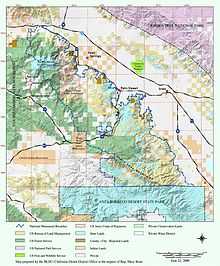Checkerboarding (land)

Checkerboarding refers to a situation where land ownership is intermingled between two or more owners, resulting in a checkerboard pattern. Checkerboarding is prevalent in the Western United States due to its extensive use in railroad grants for western expansion, although it had its beginnings in the canal land grant era.[1]
Railroad grants
Checkerboarding in the West occurred due to railroad land grants where railroads would be granted every other section along a rail corridor. These grants, which typically extended 6 to 40 miles (10 to 64 km) from either side of the track,[2] were a subsidy to the railroads. Unlike per-mile subsidies which encouraged fast but shoddy track-laying, land grants encouraged higher quality work, since the railroads could increase the value of the land by building better track. The government also benefited from the increased value of the remaining public parcels.[2]
Railroad land grants split the land surrounding the area where train tracks were to be laid into a checkerboard pattern. Each block of land (640 acres) was then numbered; odd-numbered plots were given to private railroad companies and the federal government kept even-numbered plots.
The federal government believed that the value of land surrounding railroads would increase as much as twofold.[3] Therefore granting land to private railroad companies would theoretically pay for itself and also increase the transportation infrastructure throughout the nation. Much to its own misfortune, the U.S. government was not able to sell much of the land that it retained after checkerboarding. This was because settlers willing to move West were not wealthy.[3] The wealthiest United States citizens of the 19th century remained in the East. The federal government would eventually give away much of this land through the Homestead Act.[3]
The first grants were given to the Mobile and Ohio and Illinois Central Railroads in 1850.[2] Additional grants were made under the Pacific Railway Acts between 1862 and 1871, when they were stopped due to public opposition. In total, 79 grants were made, totaling 200,000,000 acres (810,000 km2), later reduced to 131,000,000 acres (530,000 km2).[2]
Native Americans
Checkerboarding also occurred due to Native American land grants, where native land was intermingled with non-native land. Many Native American tribes oppose checkerboarding, because it broke up traditionally communal native settlements into many individual plots, and allowed non-natives to claim land within those settlements.
The Dawes Act of 1887 created most Native American checkerboarding. The act was intended to bolster self-sufficiency giving each individual between 40 acres (160,000 m2) and 160 acres (650,000 m2).
Problems
Checkerboarding can create problems for access and ecological management. It is one of the major causes of inholdings within the boundaries of national forests. As is the case in Northwestern California, checkerboarding has resulted in issues with managing national forest land.[4] Checkerboarding was previously applied to these areas during the period of western expansion, and they are now commercial forest land. Conflicting policies establishing the rights of the private owners of this land have caused some difficulties in the local Hardwood timber production economy.
While relieving this land from its checkerboard ownership structure could benefit the timber production economy of the region, it is not always the case that national forests would be better off without any private owners. When a national park is divided into a checkerboard with private owners controlling some of the land, the area over which forest land can be publicly managed is greatly increased.[5]
Native Americans were also negatively affected by federal government checkerboarding policies because railroad land grants were not immune to running through land previously occupied by Native American tribes. This act of unrightful land transfer from the hands of Native Americans to private railroad companies and homestead grantees resulted in conflicts on more than one occasion.
One notable location of conflict is the Chambers Checkerboard – a region occupied by Navajo people before railroad companies were granted the land to construct the transcontinental railroad. Tension grew between the Navajo tribe and the settlers of the region due to unexplained deaths that each party blamed on the other. These tensions led to further violence after a white settler was suspected for murdering a Navajo youth without rightful punishment.[6]
See also
- Golden Checkerboard – about the checkerboard Indian Reservation of the Agua Caliente Band of Cahuilla Indians in Palm Springs, California and the subsequent legal problems resulting from the Dawes Act.
References
- ↑ Draffan, George (1998). "Taking Back Our Land". United States: www.landgrant.org. Retrieved 28 February 2011.
- ↑ 2.0 2.1 2.2 2.3 Walton, Gary M.; Rockoff, Hugh (2005). "Railroads and Economic Change". History of the American Economy (10th ed.). United States: South-Western. pp. 313–4. ISBN 0-324-22636-5.
- ↑ 3.0 3.1 3.2 Chavez, Merry J. (1987). Public Access to Landlocked Public Lands. Stanford Law Review. pp. 1373–1401. JSTOR 1228850.
- ↑ Poli, Adon (1956). Ownership and Use of Forest Land in Northwestern California. University of Wisconsin Press. pp. 144–151. JSTOR 3159757.
- ↑ Ballaine, Wesley C. (1953). The Revested Oregon and California Railroad Grand Lands: A Problem in Land Management. University of Wisconsin Press. pp. 219–232. JSTOR 3144830.
- ↑ Kelley, Klara; Francis, Harris (2001). "Many Generations, Few Improvements: "Americans" Challenge Navajos on the Transcontinental Railroad Grant, Arizona, 1881–1887". American Indian Culture and Research Journal. Retrieved 28 February 2011.
Further reading
- Akee, Randall (November 2006). "Checkerboards and Coase: Transactions Costs and Efficiency in Land Markets". Discussion Paper Series. IZA DP No. 2438 (in English) (Bonn, Germany: Forchunginstitute zur Zukunft der Arbeit [Institute for the Study of Labor] (IZA)).